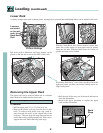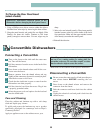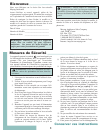
4
Dishwashing Essentials
Hot Water
For optimal cleaning and drying results, hot water
is necessary. The incoming water temperature
should be 120-140º F (49-60° C) to properly acti-
vate the detergent and melt greasy food soils.
To check the incoming water temperature, turn on the hot
water faucet nearest the dishwasher and let it run into a
glass in the sink. Place a candy thermometer in the glass
and check the temperature once it has stopped rising. If
the temperature is below 120º F (49º C), have a qualified
person raise the water heater thermostat setting.
Before starting the dishwasher, turn on the hot water
faucet and let it run until the water is hot. This assures
that the initial fill of water is hot.
Detergent
Use a detergent designed specifically for use in an auto-
matic dishwasher. Be sure it is fresh and stored in a cool,
dry place (not under the sink).
Recommended Amount
The amount of detergent to use depends on the water
hardness* (measured in grains per gallon –– gpg) and
the amount of soil on the dishes. Too little detergent
results in poor cleaning, hard water filming/spotting and
poor drying. Too much detergent can cause permanent
etching/cloudiness.
As a rule, use 1 teaspoon of detergent per grain of water
hardness. In soft water, a minimum of 3 teaspoons is
recommended.
Water Hardness* Detergent Amount per Cup
Soft (0-3 gpg) 3 teaspoons
Medium (4-9 gpg) 4-9 teaspoons
Hard (10-12 gpg) 10-12 teaspoons
*Your local water utility or state university extension service
can tell you the degree of water hardness in your area.
For water hardness of 13-14 gpg add more detergent (1
teaspoon for each gpg above 12) to the beginning of the
main wash portion of the cycle. Unlatch the door, open it
slowly and add detergent to the bottom of the tub.
If water hardness is 15 gpg or harder, it is difficult to
achieve good results with
any dishwasher. The solution
is a mechanical water softener to improve water quality,
detergent effectiveness, and protect the dishwasher parts
from the damage that hard water deposits can cause.
Detergent Placement
The recommended amount of detergent is the per cup
dosage. Do not divide this amount between cups. Each
line in the detergent cup represents 3 teaspoons. Add
detergent just before starting the cycle and close the
cover. The detergent automatically dispenses.
For
Heavy or Normal Wash, place the recommended
amount of detergent in both the PRE WASH and MAIN
WASH cups.
Light Wash requires detergent in the MAIN WASH cup
only.
Do not use detergent with Rinse Only. Leave the deter-
gent cup lid open when running
Rinse Only.
Rinse Aid
Regular use of a rinse aid improves drying, reduces
spotting and filming, and reduces moisture left on
the dishwasher interior.
Your dishwasher features an automatic rinse aid dis-
penser located near the detergent cups in the door.
The clear window in the center of the dispenser cap
allows you to see if there is rinse aid in the reservoir.
When the window is colored, there is rinse aid in the dis-
penser. When the window becomes clear, it is time to
refill the dispenser. Check the dispenser monthly.
To add rinse aid to the dispenser, turn the cap counter-
clockwise to open. Remove the cap and pour liquid rinse
aid into the opening. Replace the cap and turn it clockwise.
Removable Utensil Basket
(Design varies by model)
For best cleaning results, prevent items from nesting
together by placing some items in the basket with handles
up and some with handles down. Load knives, handles up,
through the slots in the covered section (when closed).
Be sure that thin, finely pointed items do not extend
through the basket. This could block the lower wash arm.
Small, lightweight items
like baby spoons and
plastic measuring spoons
should be placed in the cov-
ered section of the basket for
washing.


















